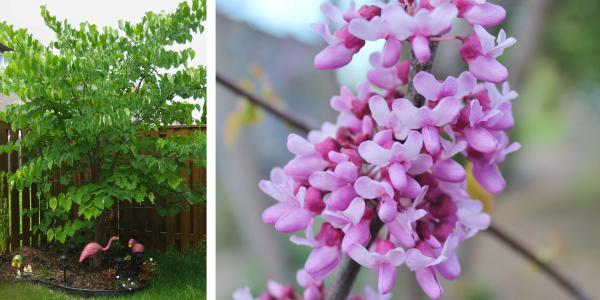In this blog, we will be focusing on four of the best early spring blooming native trees. Read on to discover why bees love trees!
Red maple Acer rubrum
The red maple is a stunning tree that captivates in every season. Its name originates from the various red elements present on the tree, including its flowers, fruit, twigs and fall foliage. These distinct features grace the red maple at different times throughout the year, making it an appealing addition to any yard.

The red maple's appeal to bees lies in its status as one of the earliest bloomers in spring. Starting in early April, the red maple bursts into vibrant blossoms, providing copious amounts of nectar and pollen for miner bees, cellophane bees and bumble bees. These rich resources play a crucial role in stimulating brood rearing and facilitating the growth of bee colonies, making the red maple a vital asset for the lifecycle of early spring bees and other pollinators.
Serviceberry Amelanchier laevis
Serviceberry is a graceful, medium-sized tree that is perfect for any space in full or partial sun. It is highly prized by homeowners (and birds) for the delicious edible berries that can be eaten right off the tree or used for baking. It has an open, rounded canopy that can be grown as a shrub or pruned into a tree form.

A sure sign of spring, serviceberry unveils showy, mildly fragrant clusters of white flowers starting in late April and peaking in May. These blossoms serve as a magnet for a diverse array of pollinators. Bumble bees, carpenter bees, miner bees and sweat bees flock to the serviceberry's blooms, alongside hoverflies, beetles, flies and even some early butterfly species. This bustling ecosystem of pollinators transforms the serviceberry into a vital hub of biodiversity during the spring.
Ohio buckeye Aesculus glabra
The Ohio buckeye stands tall as a majestic, large-growing tree, distinguished by its unique form. It has an unusual, broad form with a rounded crown and low, drooping branches that curve up at the tips. As one of the early heralds of spring, it unfurls its striking palmate compound leaves, adding a burst of greenery to the landscape. It gets its name for being the state tree of Ohio and for the resemblance of its nut to the eye of a buck.

All of these features should be enough to attract the attention of any homeowner. However, if you're still not convinced, just picture the breathtaking sight of its stunning yellow clusters of flowers, which not only adds an extra layer of beauty to your yard but is also highly attractive to pollinators. In May, these blooms offer immense amounts of nectar that are particularly sought after by long-tongued bees like bumble bees, long-horned bees, mason bees and digger bees. Ohio buckeye is also an important source of nectar for the ruby-throated hummingbird!
Eastern redbud Cercis canadensis
Eastern redbud is a shrub with a spreading, multi-trunked growth habit. If desired, it can be pruned into a tree form. It offers vibrant heart-shaped leaves that turn from reddish-purple to green and then to shades of yellow, orange or red in the fall. Adaptable to various soil types, including clay and loam, this tree thrives in well-drained locations and is a popular choice for gardens due to its ornamental value.

However, the profusion of pink to purple flowers along the twigs and branches, which bloom before the leaves emerge in spring, makes the eastern redbud popular with both people and pollinators. These blooms provide abundant nectar and pollen for native bees such as bumblebees, long-horned bees, cuckoo bees, mason bees, miner bees and sweat bees in early to mid-spring. Given that the flowers appear from April to May, the eastern redbud serves as a highly important food source for pollinators.
To help promote Backyard Biodiversity, planting these particular native trees and shrubs in your yard will go a long way in supporting the lifecycle of our native bees. Ready to get started? Plant for less through our subsidized Backyard Tree Planting Program! Check out our Homeowners page to get started on native tree planting and our Shrubs page to order native shrubs.
Justin Lewis is the Marketing and Communications Lead at LEAF.
The #BackyardBiodiversity campaign is a partnership initiative with the Toronto Wildlife Centre and is supported by Ontario Power Generation.
LEAF offers a subsidized Backyard Tree Planting Program for private property. The program is supported by the City of Toronto, the Regional Municipality of York, the City of Markham, the Town of Newmarket, the Regional Municipality of Durham, the Town of Ajax, the Township of Brock, the Municipality of Clarington, the City of Oshawa, the City of Pickering, the Township of Scugog, the Town of Whitby and Ontario Power Generation.
